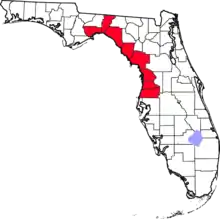
The Nature Coast is an informal, unofficial region of the U.S. state of Florida. The broadest definition of the Nature Coast includes the eight counties that abut the Gulf of Mexico along the Big Bend Coast defined by geologists: from west to east, Wakulla, Jefferson, Taylor, Dixie, Levy, Citrus, Hernando, and Pasco counties.[1][2] (Note that the Big Bend Coast differs from the Big Bend region of Florida.) The name "Nature Coast" was originally devised as part of a marketing campaign to promote tourism in Levy, Citrus, Hernando, and parts of Marion and Pasco counties.[3]
Many businesses and organizations incorporate "Nature Coast" in their names, but most of them do not explicitly define the region, or define a smaller region. For instance, the Nature Coast State Trail, which is officially designated as part of Florida’s Statewide System of Greenways and Trails, is located in Dixie, Gilchrist and Levy counties.[4][5] The Nature Coast Aquatic Preserve includes 800 square miles (2,100 km2) of coastal water in Citrus, Hernando and Pasco counties.[6] The Nature Coaster website covers only Citrus, Hernando and Pasco counties.[7]
This region of Florida is culturally partially southern, with the Deep South culture extending to Levy County. The lower southern end (Pasco, Hernando, and Citrus County) are often considered part of the Tampa Bay Area.
Activities common in this area include hunting, fishing, boating, bird watching and nature hiking. Snorkeling spots are found in the rivers along the Nature Coast. Diving and manatee tours are available, predominantly in areas such as Crystal River, Homosassa and Homosassa Springs.
The Nature Coast is home to wildlife including deer, wild pigs, roseate spoonbills, alligators, raccoons, opossums, snakes, great blue herons, egrets, turtles and at least 19 endangered species.
There are also 50 golf courses in the area.
Attractions
Citrus
- Chassahowitzka National Wildlife Refuge, partly in Hernando County
- Crystal River Archaeological State Park
- Crystal River National Wildlife Refuge
- Crystal River Preserve State Park
- Homosassa Springs Wildlife State Park
- Lake Rousseau
- Withlacoochee State Trail
- Yulee Sugar Mill Ruins State Historic Site
Hernando
Jefferson
Levy
Marion
Pasco
Taylor
Wakulla
See also
- Florida Suncoast - to the south
- Forgotten Coast - to the north and west
References
- ↑ "Where would you like to go?". Florida Nature Coast. Archived from the original on November 11, 2019. Retrieved May 22, 2018.
- ↑ "Florida Nature's Coast". Nature Coast Coalition. Retrieved May 22, 2018.
- ↑ "Marketing the Nature Coast". Tampa Bay Times. Retrieved 2023-07-09.
- ↑ "Nature Coast State Trail". State of Florida. Archived from the original on May 15, 2012. Retrieved May 18, 2012.
- ↑ "Nature Coast State Trail". Florida Nature Coast. Retrieved May 22, 2018.
- ↑ "Nature Coast Aquatic Preserve". Florida Department of Environmental Protection. Retrieved 2023-07-09.
- ↑ "Nature Coast Area Map". NatureCoaster. Retrieved May 22, 2018.
External links
- Nature Coast Coalition List of attractions and events
- Florida's Nature Coast Conservancy
